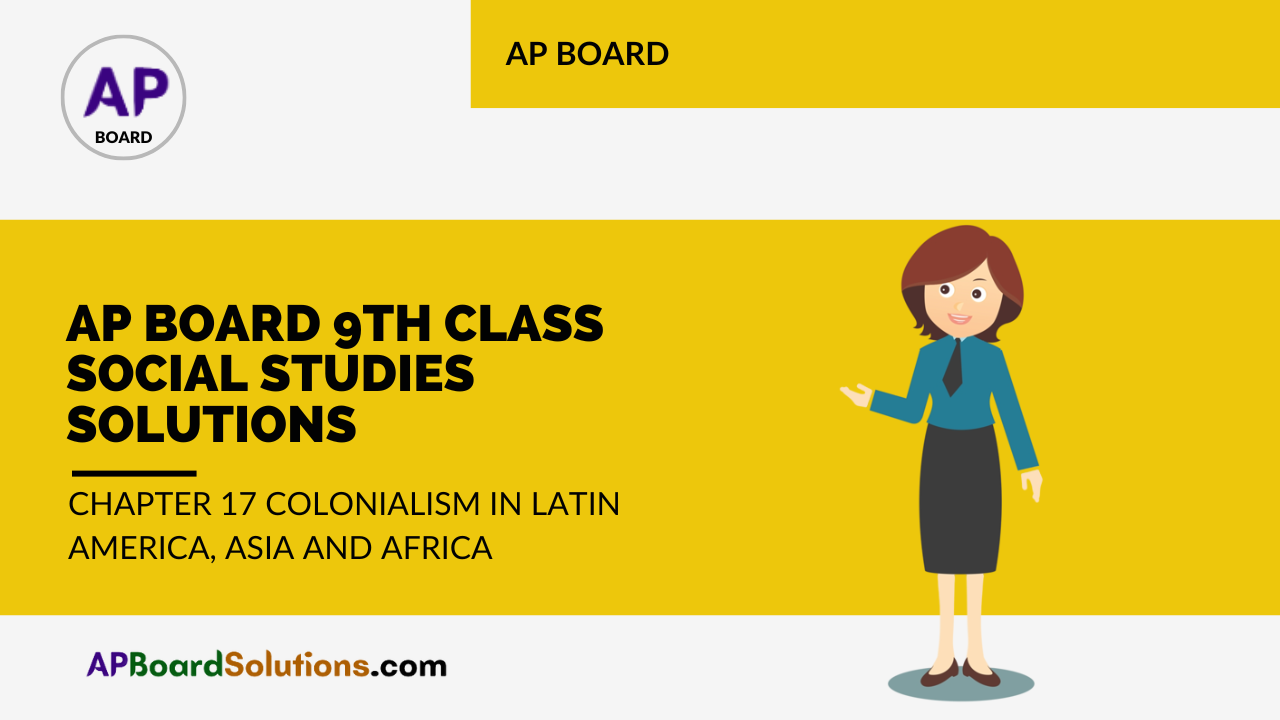SCERT AP Board 9th Class Social Solutions 17th Lesson Colonialism in Latin America, Asia and Africa Textbook Questions and Answers.
AP State Syllabus 9th Class Social Studies Solutions 17th Colonialism in Latin America, Asia, and Africa
9th Class Social Studies 17th Lesson Colonialism in Latin America, Asia and Africa Textbook Questions and Answers
Improve Your Learning
Question 1.
Match the following :
| Group – A | Group – B |
| 1. Opium war | A) Belgium |
| 2. Ottoman empire | B) Spain |
| 3. Personally owned the | C) Controlled trade before colonization |
| 4. Setting farmers | D) China |
Answer:
| Group – A | Group – B |
| 1. Opium war | D) China |
| 2. Ottoman empire | C) Controlled trade before colonization |
| 3. Personally owned the | A) Belgium |
| 4. Setting farmers | B) Spain |
Question 2.
How is the word ‘discovery’ and ‘exploration’ used by Europeans? What did it mean to people who were already living in those geographical locations?
Answer:
Discovery:
- The word “discovery” means “finding something that we did not know about it before”.
- But in European concept “discovery” is to find faster and easier routes to countries like India, China etc., without passing through regions controlled by Italian traders.
Exploration :
- The step next to discovery is exploration.
- Exploration in European context means “Sending expedition to countries and finding out what resources were available.”
- Europeans explored the backward African and Asian countries for natural resources like, gold, silver, silk, porcelain etc.
Views of native people :
- But the Europeans did not explore these countries but exploited them.
- Virtually the Europeans enslaved them, plundered them, forced them to trade with them etc.
- In South America the natives were deprived of their land and were massacred and driven to interiors.
![]()
Question 3.
What role did trade play in the colonisation?
(OR)
“Trade played a major role in the colonisation.” Do you agree? Why?
Answer:
Yes. I agree with this statement.
Reasons:
- Trade played an important role in colonizations.
- Trading items include silk, porcelain, tea, etc., from China; cotton textiles, steel and spices from India; tin, petroleum, rubber, spices, etc., from Indonesia and natural resources from Africa.
- The Europeans had established trading centres in these countries.
- They demanded monopolistic trade relations for the benefit of the colonial powers.
- The European powers had bought these exotic goods and sold them in Europe and made high profits.
- The first Dutch expedition, for example, fetched about 400% profit on its investment.
- As much of 25% of the Dutch government budget came from these profits.
- The English people forced Indians to produce opium and sold that opium in China and earned heavy profits.
- Thus trade played an important role in colonization.
![]()
Question 4.
How did the lives of native people in different countries affect the colonisation? Write two ideas each in the context of – crops cultivated/religion/use of natural resources – for the three continents.
Answer:
- Most of the countries were self-sufficient before colonization.
- These colonies were impoverished during colonial powers.
Crops cultivated :
- They were cultivating food crops and the colonies in all three continents were forced to cultivate commercial crops.
- There were shortage of food items and famines and droughts were frequent.
Religion :
- In Asia people were Hindus, Muslims and Buddhists. In Indonesia Muslims were massacred and forced to convert into Roman Catholism.
- In other continents also the Catholic Church played important role in the governance of the colonies.
Use of natural resources :
- All the natural resources like gold, diamonds, silver, iron, coal, tin, rubber, silk, copper were plundered and taken into their countries.
- Colonial powers developed industries in their countries with these resources.
Question 5.
Compare the nature of colonial rule over China and India and Indonesia. What difference and similarities do you find between them?
Answer:
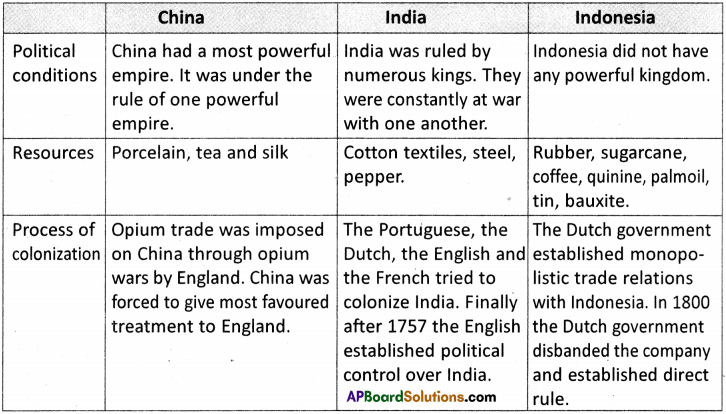
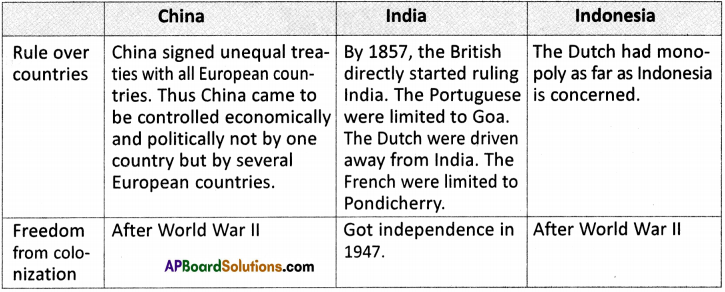
Question 6.
Locate the Portuguese, Dutch, British and French colonies in the world map and filled with different colours.
Answer:
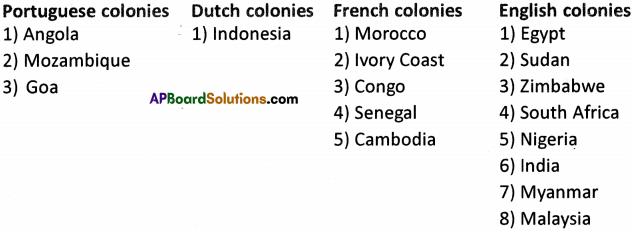

Question 7.
If you were a citizen of Britain, could you support its colonisation? As an Indian citizen could you support or reject colonisation. Give a brief account of your views.
Answer:
Attitudes towards colonialism have varied greatly from time to time and from place to place. I think this is ever present truth that the strong dominate the weak.
If I were a citizen of Britian or as Indian I strongly oppose this colonisation. Because every living being in this world has the freedom in the world. So I don’t like to arrest the others’ freedom.
9th Class Social Studies 17th Lesson Colonialism in Latin America, Asia and Africa InText Questions and Answers
Question 1.
Which of the continents were they not familiar with at all? (Text Book Page No. 205)
Answer:
The Europeans were not familiar with the continents of South America and North America.
Question 2.
Which were the continents whose coastal areas were known to them but not the interior regions? (Text Book Page No. 205)
Answer:
- The coastal areas of Africa were known to the Europeans.
- They established trade relations with Asian countries during ancient and medieval periods. Hence the coastal areas of Asia were also known to them.
Question 3.
Why do you think the Spanish Settlers were not allowed positions of importance in the government of the colonies? (Text Book Page No. 208)
Answer:
- Even though the direct colonial rule ended, many remains of the old colonial rule remained.
- Latin Americas had a social system which consisted of very large landlords, a large number of slaves, semi slaves and poor small farmers.
- Industry and trade were under the control of the landlords.
- These landlords paid no interest in developing.
- Old colonialism continued to influence the Latin Americas even after the end of the colonial regime.
![]()
Question 4.
Compare the Zamindari system in the Nizam state and the haciendas of South America. What similarities and differences do you find between them? (Text Book Page No. 209)
Answer:
- Haciendas were estates of thousands of acres which contained silver and copper mines, agricultural lands and also factories. They were owned by landlords.
- “Zamindari System” was created by the government. Zamindars were appointed and they were made the owners of the lands. Original owners became tenants.
- Landlords used to employ peons or unfree Indians and African slaves to work on Haciendas.
- Tenents used to work on the lands in Zamindari system and taxes were collected by the Zamindars.
Question 5.
Why do you think the Latin American countries remained undeveloped despite getting independence from colonial rule? (Text Book Page No. 211)
Answer:
I think that the Latin American countries remained undeveloped despite getting independence form colonial rule due to the following reasons :
- Poverty,
- Corruption,
- Lack of a manufacturing base,
- Drugs,
- Poor leadership and
- The U.S.A.
Question 6.
In what way did the Munroe doctrine protect the independence of Latin America? Did it also limit their freedom? (Text Book Page No. 211)
Answer:
- The Munroe doctrine had no clarity regarding the independence of Latin America.
- It asserts that European powers should not consider colonising any American country but it allows an American country to colonize these countries.
Question 7.
How did Britain gain from the Munroe Doctrine? (Text Book Page No. 211)
Answer:
- Britain which had a powerful navy supported the Munroe Doctrine.
- Britain was keen that the American colonies were not under political control of any European power so that they would be free to trade with England and purchase its industrial goods.
Question 8.
Fill in the blanks : (Text Book Page No. 215)
a) Main products imported by western countries from China were ………………………….. and ………………………….. .
b) The product that western countries tried to sell in China was …………………………..
c) Asian country that tried to influence trade in China was …………………………..
Answer:
a) silk, porcelain and tea
b) opium
c) Japan
![]()
Question 9.
Read the following passage and answer the questions given below.
| Most of the trade routes connecting Europe and Asia around 1400 were controlled by Muslim kingdoms, especially the Ottoman Empire which was constantly at war with the European Christian powers. The Italians were able to work out an understanding with the Arab traders who brought Asian goods to the Alexandria (in Egypt) and sold them to the Italians. As traders and governments of western Europe like Holland, Spain, Portugal and England realised the importance of this trade, they wanted to find faster and easier routes to countries like India and China, without passing through regions controlled by Italian traders. The Portugese for example, wanted to find a route around Africa to reach India. The Spanish wanted to know if it was possible to reach India by crossing the Atlantic Ocean. They invested huge fortunes by hiring experienced sea mariners and giving them ships and other resources to explore. This led to the discovery of Central America by Christopher Columbus in 1492 and of sea route to India around Africa by Vasco Da Gama in 1498. Columbus was working on behalf of the Spanish queen while Vasco da Gama was working for the Portugese king. Soon English and Dutch governments too were sending their sailors to these regions. |
a) Why do you think the Italians were controlling the trade with Asia in 1400 and not other Europeans like Portuguese or Spanish? (Text Book Page No. 206)
Answer:
- As per theory the Italians came to an understanding with the Arab trader who brought Asian goods to the Alexandria and sold them to the Italians.
- But in reality Italy is in the Mediterranean sea and is very accessible to Egypt, Middle east and east Asian countries. Hence developed good trade with them.
b) Why were the Portuguese and Spanish keen to find other routes to reach Asia? (Text Book Page No. 206)
Answer:
- Italy developed due to the Asian trade.
- So other countries realised the importance of this trade.
- They wanted to find faster and easier routes to countries like India and China without passing through regions controlled by Italian traders.
Question 10.
Look at the map of South America around 1800 to identify the countries controlled by the different powers. (Text Book Page No. 202)
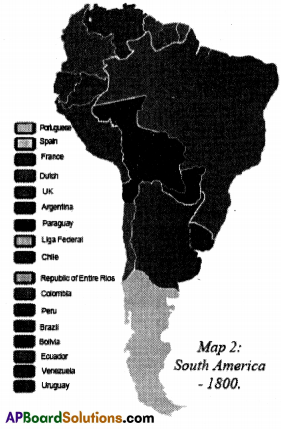
Answer:
Student activity.
Question 11.
Try to formulate the grievances of the following people of the Latin American colonies. (Text Book Page No. 209)
1) Spanish settlers who owned haciendas
2) Small Spanish farmers settled in America
3) Native Americans
4) African slaves settled in Latin America.
Answer:
- a) Haciendas were estates of thousands of acres.
b) These estate owners had no intensives to use modern methods of cultivation or production as they had a supply of cheap abour. - Small Spanish farmers did not have any role in the administration of the colonies which were controlled by the Spanish from Europe.
- A large number of native Americans had been killed. The survied were heavily taxed, and had to provide labour supply to the mines and farms owned by the Spanish.
- Most of the African slaves were forced to work on the haciendas.
![]()
Question 12.
Look at the Map of Africa in 1913 to see the extent of colonial possessions of the European powers in Africa.
Compare the map with a modern map of Africa.
Make a list of the large African countries and write against their names the countries that had colonised them. (Text Book Page No. 216)

(OR)
Look at the two maps given beiow Map A shows the European colonies in Africa in 1913-14 and Map B shows the modern countries of Africa.
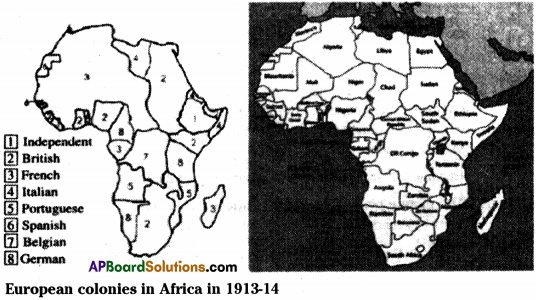
Compare the information in this two maps. Draw the table given below in yours answer sheet and write the name of the colonising country against the African Country given.
Answer:
| Modern country | Colonial power in 1913 |
| 1. South Africa | Britain |
| 2. Egypt | Britain |
| 3. Nigeria | Britain |
| 4. Ghana | Britain |
| 5. Libya | Italy |
| 6. Algeria | Italy |
| 7. Angola | Portuguese |
| 8. Congo | Belgium (Later it became French colony) |
